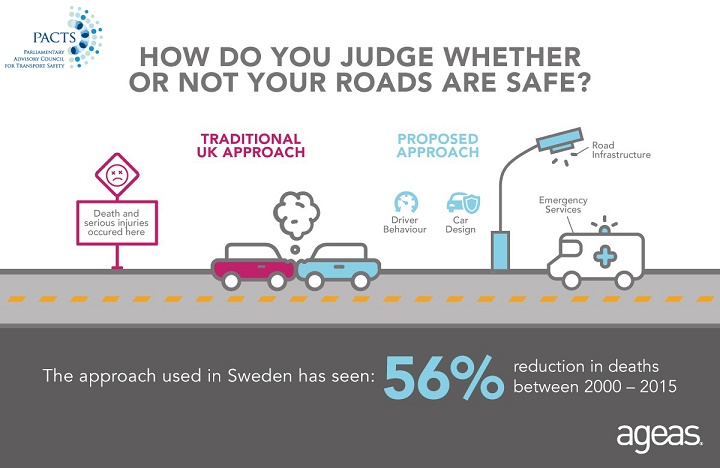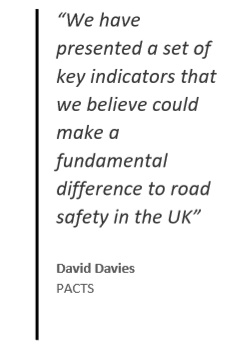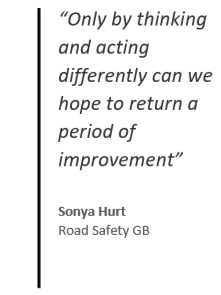
The Government is being urged to adopt a set of road safety ‘performance indicators’, based on international good practice and tailored to UK needs.
In a new report, the Parliamentary Advisory Council for Transport Safety (PACTS) says the performance indicators would cover roads, vehicles, users and emergency services in order to focus ‘scarce resources’ on the most effective actions.
In the report, which has been welcomed by Road Safety GB, PACTS proposes a framework which recognises that the safety of the entire road system needs to be considered to reduce deaths and serious injuries – not simply driver behaviour.

PACTS says adopting such a system would give practitioners the breadth of information they need to assess the performance of their road network.
The indicators proposed by PACTS are:
- Percentage of traffic complying with speed limits on national roads
- Percentage of traffic complying with speed limits on local roads
- Percentage of drivers who do not drive after consuming alcohol or drugs
- Percentage of car occupants using a seat belt / child seat
- Proportion of drivers not using an in-car phone (handheld or hands free)
- Percentage of new passenger cars with highest Euro NCAP safety rating
- Percentage of roads with appropriate iRAP rating
- Percentage of emergency medical services arriving at accident scene within 18 minutes
David Davies, executive Director of PACTS, said: “It’s been three years since the DfT recognised the value this approach could offer UK road safety, but the performance framework to support it has not been developed.
“PACTS is pleased to have undertaken this research, with support from leading experts and stakeholders. We have presented a set of key indicators that we believe could make a fundamental difference to road safety in the UK.
“As UK casualty figures have shown almost no progress since 2010, we believe it is badly needed.”
Sonya Hurt, chair of Road Safety GB, said: ‘’Road Safety GB is delighted to see PACTS publish this paper which reflects our view that performance measurement will be a key element in the changes we need to make nationally to address the ongoing road safety challenge.
“Framing these performance measures in the context of a Safe System model is especially welcome. The levelling off of road casualties statistics in recent years – compared to our previous steady progress – suggests that only by thinking and acting differently can we hope to return a period of improvement.

“Safe Systems approaches offer such an opportunity for change and it will be essential for us to work to common and easily understood performance measures to track our progress.”
Although using slightly different indicators to those proposed for the UK, PACTS says in the first 15 years of using the system (known as Vision Zero) in Sweden, there were 56% fewer deaths.
Claes Tingvall, formerly of the Swedish Transport Administration, said: “It is not possible to manage actions that are effective simply on crash outcome.
“You need to work backwards in the chain from the result you desire and see what you need to get there in terms of the traffic system.
“In most cases we find that a combination between an infrastructure, right driver behaviour and vehicles of a certain safety standard leads to a certain improved outcome.”
Andy Watson, CEO of the insurer Ageas who sponsored the report, said: “Traditional measures do not give a complete picture of road safety management.
“An evidence based solution, together with a detailed set of key performance indicators on road safety, is a proven way of focusing efforts on reducing casualties and deaths.”
The report was launched on 2 October at the Conservative party conference in Birmingham.
Speaking at the launch, Jack Brereton MP, member of the Transport Select Committee, said: “I’m delighted to support the publication of this vital report which promotes a wider approach to reducing the dangers on our roads.”
David
Thanks for replying. But in the case of 20mph roads, DfT only has 8 sites across the whole country and these have been chosen for being “free-flowing” and without any observable hazards. We have mapped the sites at https://tinyurl.com/DFT20mphATC You can see from this that, just as DfT say, they are atypical of most 20mph roads. This has already resulted in those ignorant of the actual sites extrapolating the results to “all drivers on 20mph roads”.
So for the speed limits that are most used to protect pedestrians and cyclists the performance indicator will not be reflective of actual safety on most 20mph roads. Furthermore the KPI will imply 20mph roads to be “less safe” due to compliance levels than similar roads with higher limits and substantially higher average speeds.
Furthermore those authorities who have followed WHO, ETSC, EU and DfT guidance to set lower speeds of 20mph where pedestrians and cyclists mix with motor vehicles will be given conflicting messages from the KPI used.
I am sure you are aware that “exceeding a limit” is a very blunt measurement. Its even blunter than average speeds and will fail to provide a representative KPI on the safety levels of 20mph and 30mph roads.
It is not that compliance shouldn’t be measured as a KPI, but to use it as the sole KPI for safe speeds on local roads without measuring actual speed is surely not in line with internationally accepted best practice. For local roads the results and the KPI will neither be robust nor credible.
Rod King, Lymm
--4
Rod, you make a good point about achieving compliance by raising the speed limit. We were aware of that sort of perverse outcome – see Ch5 on Limitations of Performance Indicators. However, the speed compliance indicators would give more detailed information about speeds – not simply a headline number. In addition, we discuss the desirability of a safe speed indicator on pp 20 and 26. It was not included in the KPI set because it would need a lot more work to define “safe speed” on all roads, and to devise a practical and robust survey method. But definitely one for the future.
David Davies
+5
Hugh, I am well aware that, on the odd occasion that I do drive, I am not always as cautious or as courteous to other road users as I should ideally be. And those times tend to be where I perceive significant peer pressure to adhere to the de-facto road-user-pecking-order convention that mandates that when in the traffic flow on “normal” main roads, drivers do not keep stopping their cars to allow pedestrians or other drivers to cross, even if those other road users were there first, and especially if one is crossing green traffic lights or exiting a roundabout.
The same applies equally when I’m travelling as a pedestrian. An example is the way I assert my priority on pedestrian crossings. Sometimes it seems I’d rather be killed than allow an errant motorist to usurp me on the black and white stripes. On the other hand, I don’t think I’ve ever knowingly been rude (or a threat) to other people in a pedestrian-only situation, such as town squares or shopping malls, where there are no regulations, lines, signals or signs unfairly interfering with the natural order of things and where “after you”, “no, after you!” is the norm.
And from my experience (as I’ve oft said elsewhere on this site), most people behave similarly differently in the regulated realm than they do in the unregulated realm.
And because of those experiences I have formed the opinion that where we are allowed to use our own free will our behaviour will always be better than it is where we are forced to work within a set of unnatural and inequitable conventions and rules. Sure we can try to ameliorate the problems (that only exist in the regulated realm) by adding ever increasing amounts of regulation and by by increasing the penalties for contraventions, but that is clearly not sustainable, and never seems to work anyway.
Charles, England
--2
As a motorist then Charles, as opposed to a pedestrian, do you find your behaviour behind the wheel to be consistently good, bad or average or is it influenced by the location at the time and in what way? If it’s hopefully consistently good, do you not wonder why the other drivers in your same location i.e. the bad and average aren’t the same? If and when your own personality or mood is variable, how does it affect your standard of driving if at all?
Hugh Jones
0
Hugh, yes there is both good and bad behaviour in all locations, which we can put down to variations in personalities, moods, etc. What I observe though is that the “average” behaviour is consistently better in certain places and consistently worse in others. That is, it is the location rather than the drivers’ inherent “goodness”/”badness” quotient that dictates their behaviour. Hence my belief that if we get the road system right, driver behaviour will look after itself.
Charles, England
--1
On the other hand Charles, there will have been both bad and good driver behaviour in the same places in the same conditions over this time – how would you explain that?
As a frustrated pedestrian, perhaps you are – understandably maybe – only naturally noticing and recalling the bad driver behaviour. Either that, or wherever you live, you have the worst drivers in ‘England’.
Hugh Jones
0
Hugh, no, It’s not the “workmen” blaming their tools – it’s me, as an external (pedestrian) observer, making these comments. These views are based on a couple of decades of observation of driver behaviour in different places and under different conditions.
Charles, England
+2
Clearly setting a 70mph speed limit for restricted roads would immediately put UK to the top of the league for “percentage of traffic complying with local speed limits”.
But would that be a “good indicator of road safety performance”?
Rod King, Lymm
+2
A case of “A bad workman always blames his tools” Charles? “It wasn’t my fault officer – it was the poor ‘performance’ of the road!” (Still don’t know what that means)
Anyway I digress and referring to the last indicator “..response time of 18 minutes” for emergency medical response – that could be relevant in whether a crash is fatal or not and could end up as a statistic, but it seems counter-productive to stipulate a response time which might put pressure on the ambulance drivers leading to their own driving being compromised, increasing the likelihood of an accident involving themselves.
Hugh Jones
--5
But Hugh, bad driver behaviour is a symptom of a poorly performing road network – well performing road networks induce good driver behaviour. The challenge is to provide a well performing network, rather than to scapegoat drivers and not accept that responsibility.
Drivers are a (large) subset of the adult population (which obviously includes all abilities and personality traits), and in a fully inclusive society, the road network needs to be able to safely accommodate all of them, and not just the elite few who have all of the super-human attributes required for the current network to be safe.
Charles, England
0
David, sure KSIs are not the only measure, but none of the proposed indicators help me to know if the roads are safe. I’m certainly interested in traffic speeds, but only at the point where I interact with the traffic – and I don’t care then what the limit is, or how many drivers stick to it. If I want to cross a 60mph road, then I expect to be able to do that without having to wait for a stream of cars to pass, most of which arrived after I did.
What we need are metrics that indicate how close the behaviour of people as drivers is (WRT interactions with other road users) to the human behavioural norm when they are not behind the wheel. This would be a true indicator of how safe the roads are and of how fit for purpose our road system is. Perhaps then too, the authorities would finally stop scapegoating motorists and start accepting responsibility for, and start tackling, the problems they themselves have created by concentrating on the symptoms (with speed limits, phone laws, etc.) rather than on the underlying disease (that people have been brainwashed from an early to accept that cars have de-facto priority on the public roads and should always be kowtowed to).
Charles, England
--4
The third paragraph says “.. the safety of the entire road system needs to be considered to reduce deaths and serious injuries – not simply driver behaviour” but of the eight indicators proposed by PACTS, the first five clearly are driver behaviour issues. Far from being ‘an assessment of the performance of the road network’ (whatever that actually means) therefore, it is actually an assessment of driver behaviour, which is as it should be and for as long as driver behaviour is as poor at is now, it will always be seen by some as an ‘unsafe road system’ which it isn’t – it just has unsafe people using it.
Hugh Jones
0
Charles, I’d urge you to read the report and consider it. The number of KSIs is only one measure of safety – and a very crude one when it comes to your safety when crossing the road. You must be familiar with the frequent Catch 22 where people don’t cross the road because it is too risky; and local highway authority response that “there are not enough KSIs” to justify taking action. Without quite detailed information about the nature and the causes of the crashes on the roads that you cross, KSI numbers or rates would not tell you much. Would you not also like to know about vehicle speeds, whether the drivers are sober and alert, if they driving safe cars, etc? We are not saying ignore KSIs, just that there are other things that also need to be monitored.
David Davies, London
+4
It was a pleasure to have contributed to this project and all credit to the PACTS team who got it out in record time. This is an important, albeit preliminary, exercise because it re-opens the door for either national targets or nationally adoptable performance indicators that offer similar benefits.
It’s also worthwhile remembering that these have been deliberately drafted to reflect a Safe Systems approach with its inherent focus on collision survivability. Inevitably people will expect to see more indicators than appear in this document – or perhaps different – but there is a clear Safe Systems rationale behind this list which may yet expand over time but remain rooted in Safe System thinking.
Jeremy, Exeter
--3
Hugh, that code is just another example of our sticking plaster approach – attempting to treat the symptoms *caused* by our failed road safety model. If drivers didn’t (wrongly) assume that they, using the road longitudinally, had absolute priority over pedestrians using the same road laterally, we could take it in turns, as would probably happen if the same people were crossing each others’ paths in a pedestrian square.
The problem is systemic and has its roots in the way we brainwash children to be bad drivers, by teaching them from the time they first start using the streets, to aspire to driving as though the car is king and must be feared and kowtowed to by all pedestrians. Remove the man-made obstacles to road safety that have been introduced since the 1930s, probably ostensibly as road safety “improvements”, and we stand a chance of eliminating road casualties. The first one, perhaps, being the oft-used notion that one stream of traffic has absolute priority over another (via regs, lines, signs, signals or whatever). Otherwise, I think, we will be forever chasing our tails and looking to scapegoat the current generation of drivers for not succeeding in fitting the square peg of the laws of human nature into the round hole of our road safety model.
Charles, England
+4
Green Cross Code Charles. It still holds good today, although I don’t believe it was ever designed to allow you to cross the road ‘when and where you want to’.
THINK! Find the safest place to cross, then stop.
STOP! Stand on the pavement near the kerb.
USE YOUR EYES AND EARS! Look all around for traffic, and listen.
WAIT UNTIL IT’S SAFE TO CROSS! If traffic is coming, let it pass.
LOOK AND LISTEN! When it’s safe, walk straight across the road.
ARRIVE ALIVE! Keep looking and listening
Sorry if it’s patronising – just trying to help.
Hugh Jones
--5
But none of the proposed road safety indicators actually indicate how safe the roads are. Surely the only worthwhile indicators are the number and severity of collisions. I don’t care how many people do, or do not wear seat-belts, so long as I can cross the roads safely when and where I want to.
Charles, England
+2